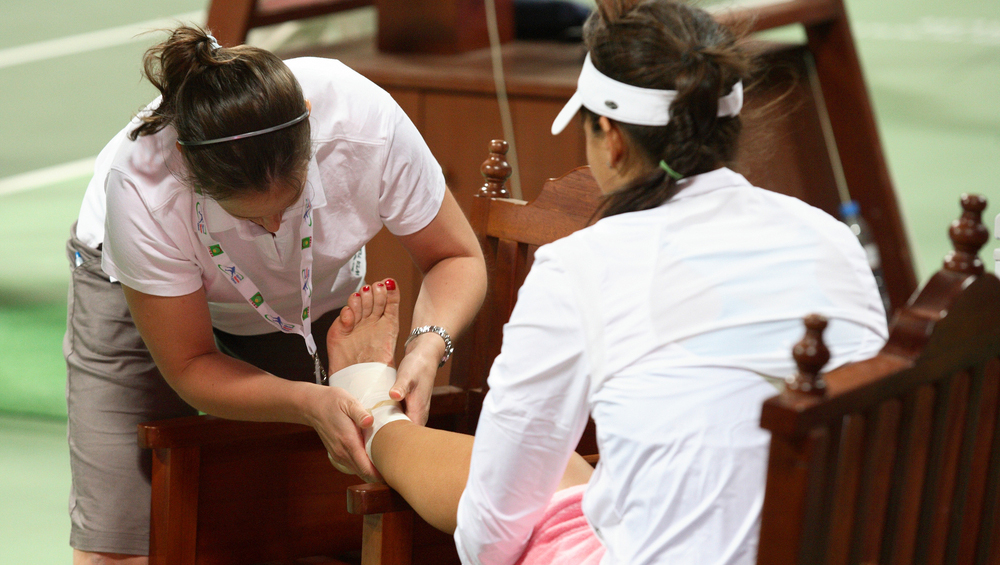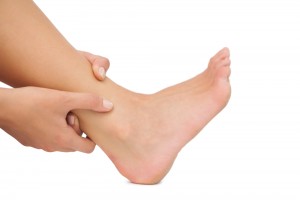Mobilizations for acute ankle sprains? Article review
Posted on 23rd December 2013 by Grant Banks

I’ve sprained my ankles more times than I can count on two hands (and feet). Landing on a foot here, tripping off of a curb there, generally lacking coordination a few times; it seems that I am always in the process of gingerly rehabilitating my swollen ankles. In fact, fate has a funny sense of irony, because I sprained my ankle two days before writing this review. As I have gone through my clinical rotations as a physical therapy student, I have also had the pleasure of treating patients’ sprained ankles as well. We all know to rest, ice, compress, and elevate (RICE) the injured joint, but I had always wondered if my mobilization treatments for an ankle sprain were actually beneficial to my patients. For non-PT’s/PT students, a mobilization a technique where a therapist applies gentle, back-and-forth pressure to a joint that causes the bones making up that joint to move in a specific direction, usually without any muscle activity from the patient aiding in that movement. What does a physical therapist do when they don’t know if their treatment is really effective? They head to the databases and review the literature, of course! So, here is my review of an article examining the efficacy of mobilizations as a treatment for acute ankle sprains:
“A Randomized Controlled Trial of a Passive Accessory Joint Mobilization on Acute Ankle Inversion Sprains” by Toni Green, Kathryn Refshauge, Jack Crosbie and Roger Adams. Physical Therapy, April 2001.
What’s the big deal with ankle sprains?
As I’ve stated, I’m a frequent ankle sprainer. However, I’m not alone! Ankle sprains, especially ankle “inversion” sprains, are very common in sports requiring running, jumping, and quick lateral movements. An “inversion” sprain occurs when your foot turns inward quickly, stretching and injuring the ligaments on the outside of your ankle. A big problem resulting from one of these sprains is the lack of dorsiflexion of the ankle (the motion of pulling your foot up, or the opposite of “pointing your toes”), which limits your ability to walk, go down stairs, run, and perform other functional and sports-related activities.
So, what did they study?
 PT’s have often treated ankle sprains with joint mobilizations to relieve pain and to improve the range of motion of the ankle. This study took 41 subjects who had all sustained an ankle inversion sprain within 72 hours and split them into two groups: the experimental group and the control group. The experimental group received anterior-to-posterior mobilizations of their injured ankle, along with a standardized RICE protocol. The control group was only treated with the RICE protocol. The subjects were treated every second day for a maximum of two weeks, or until they achieved the established discharge criteria: the attainment of pain-free dorsiflexion range of motion of the injured ankle equal to the uninjured ankle. The outcome measures studied were pain-free dorsiflexion range of motion and three gait variables: stride speed, step length symmetry, and single support time (relative to the uninjured leg).
PT’s have often treated ankle sprains with joint mobilizations to relieve pain and to improve the range of motion of the ankle. This study took 41 subjects who had all sustained an ankle inversion sprain within 72 hours and split them into two groups: the experimental group and the control group. The experimental group received anterior-to-posterior mobilizations of their injured ankle, along with a standardized RICE protocol. The control group was only treated with the RICE protocol. The subjects were treated every second day for a maximum of two weeks, or until they achieved the established discharge criteria: the attainment of pain-free dorsiflexion range of motion of the injured ankle equal to the uninjured ankle. The outcome measures studied were pain-free dorsiflexion range of motion and three gait variables: stride speed, step length symmetry, and single support time (relative to the uninjured leg).
The results are in!
In regards to dorsiflexion range of motion, the group that received the mobilizations showed greater improvements in a faster period of time than the group that received only RICE (rest, ice, compression, and elevation; eating rice has not been studied for its effects on ankle sprains… yet). The subjects in the experimental group also showed greater improvements in stride speed and step length symmetry in fewer treatments than the control group. Symmetry of single leg support time improved for both groups and was highly variable depending on the individual subject, and therefore no statistical differences in this outcome were found between the two groups.
So, to put it all together…
This study shows that using anterior-to-posterior mobilizations following an acute ankle inversion sprain could be a valuable addition to the standard RICE protocol for patients by promoting a faster recovery of pain-free dorsiflexion range of motion, stride speed, and symmetrical step length.
Overall Impressions
I think that the authors did a very good job with this study by using repeatable, valid methods and preventing a lot of variables from confounding their study. They used the same therapist to treat all of the subjects which was a great way of making sure that the mobilizations provided throughout the study were similar. They used effective methods for obtaining their outcome measurements, including a very advanced camera system and a valid method for measuring dorsiflexion. I also think that their use of symmetry when examining stride length and single support time was appropriate, since it accounted for the inherent intersubject variability. The authors did include one procedure that I found strange, which was taping the injured ankle after the third treatment session. After the study was conducted, the authors decided not to include data from treatment sessions after the third, which essentially negated any confounding effects that the taping could have had on the study. However, it could have proven to be a big source of variability in the study if data after the third treatment session had been used in the data analysis. The subjects were not statistically similar at the outset of the study in terms of history of ankle sprains, which does limit this study’s strength. However, that issue was due to the random assignment of the subjects into their groups, so the authors could not have controlled for this limiting factor.
The final verdict.
Am I going to use mobilizations, when appropriate, to treat my all-to-common ankle sprains and my future patients’ ankle sprains? Absolutely.
Reference:
- Green T, Refshauge K, Crosbie J, Adams R. A randomized controlled trial of a passive accessory joint mobilization on acute ankle inversion sprains. Phys Ther. 2001;81(4):984-94.




No Comments on Mobilizations for acute ankle sprains? Article review